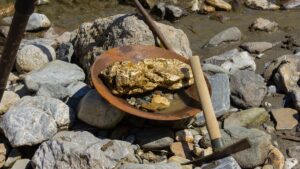Monsters of Rock: Gold miners will be happy to see the back of this reporting season

Pic: Getty
More gold miners have received a frosty reception from investors in an earnings season the sector will be pleased to just see the back of.
Ramelius Resources (ASX:RMS) and St Barbara (ASX:SBM) were the latest to disappoint with their results, with labour issues, falling or stagnant profits, Covid and rising costs weighing across the Australian gold industry.
Gwalia gold mine owner St Barbara, which produced 132,524oz of gold in the December half at $1539/oz, saw its underlying profit drop 63% year on year to $15m.
It has been heavily impacted by Covid outbreaks across the Tabar Island group in Papua New Guinea where St Barbara runs the Simberi gold mine and has been struggling to field a full roster with a third of its workforce still in iso.
St Barbs has withdrawn guidance at Simberi and suspended its interim dividend on the uncertainty. Longer term, St Barbs has set an “aspirational target” of becoming a 600,000ozpa miner from 2025.
That will include 270,000ozpa from its flagship Gwalia operations in WA, where it recently announced the takeover of Bardoc Gold (ASX:BDC) to expand its resource and reserve base, 180,000ozpa from Simberi with an investment decision expected soon on a sulphide expansion and 150,000ozpa from the Atlantic Gold operations in Canada.
RBC Capital Markets analyst Alex Barkley said the Atlantic output target was around 30,000oz higher than RBC estimates but 25,000oz below previous long term guidance.
“Guidance includes Simberi Sulphide, where SBM expects an FID in April 2022,” he said. “In our view, SBM will need to achieve greater short-term operational consistency before the market is likely to fully value the company’s long-term potential.”
Profits down as Ramelius sees costs rise
Ramelius shares fell almost 9% in the morning before settling to a more stable 4.7% drop by 2.30pm AEDT after revealing a 32% drop in underlying NPAT to $53.3m and 10% fall in reported NPAT from $81.3m in the first half of 2021 to $73.4m in the first half of 2022.
It came as all in sustaining costs rose 17% on the prior corresponding period to $1473/oz and gold production fell from 144,240oz to 132,605oz.
Ramelius did not declare a dividend, with lower head grades and rising costs to blame for the weaker result.
The reported profit was supported by the $30.3m pre-tax sale of Ramelius’ royalty over the Kathleen Valley lithium mine to Liontown Resources (ASX:LTR).
Ramelius does have $147m of inventories sitting in stockpiles, with a shortage of truck drivers due to WA’s hard border impacting its ability to transport high grade ore from its Tampia and Marda satellite mines over to the Edna May processing plant.
On a call with investors and analysts today Ramelius MD Mark Zeptner said he was hopeful the reopening of WA’s state border in March would alleviate the labour pains.
“We will be bringing people in through March who were previously required to quarantine and they don’t, but we hope to build on that from there and to go not only to planned haulage levels, but to go beyond,” he said.
“Obviously, we’ve got considerable stocks and we’ve got the ability to do that.”
“I suppose the unknown everybody’s going to have to deal with is you might gain some people, but do you lose some at the same time once the borders open?”
Ramelius is planning to add additional high grade production into its schedule with the start of mining at the Penny mine in early FY23, which at 14g/t boasts one of the highest grade ore reserves in Australia.
Barkley, who also covers Ramelius for RBC, said operating cash flows of $78m were higher than expected, but lamented a lack of updates on major underground and expansion projects at the Galaxy deposit at Mt Magnet and Edna May.
On the flip side, African gold miner Perseus Mining (ASX:PRU) announced a dividend of 0.81c per share (try do that maths in your head), as profit after tax climbed 159% to $126.9m with EBITDA 101% higher to $252.4m.
“With three gold mines in operation, we are now producing gold at our targeted rate of approximately 500,000 ounces of gold per year, and with excellent drill results coming from our organic growth programmes we are confident of at least maintaining this level of production and associated profitability well into the future,” Perseus MD Jeff Quartermaine said.
“We have achieved these results in a West African setting with the COVID pandemic providing a backdrop, which I believe speaks volumes of the efforts of individuals in our teams at the mines, in the field and in our offices across Africa and Australia.”
“It also underlines our collective commitment to our mission of creating material benefits for all of our stakeholders, in fair and equitable proportions.”
Gold miners share prices today:
Related Topics

UNLOCK INSIGHTS
Discover the untold stories of emerging ASX stocks.
Daily news and expert analysis, it's free to subscribe.
By proceeding, you confirm you understand that we handle personal information in accordance with our Privacy Policy.








